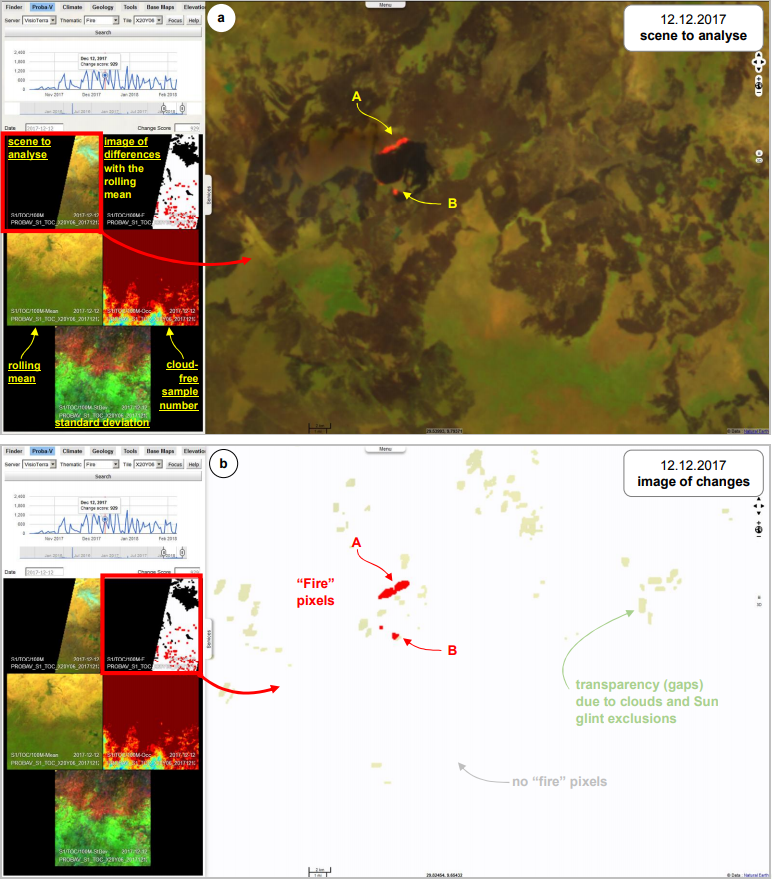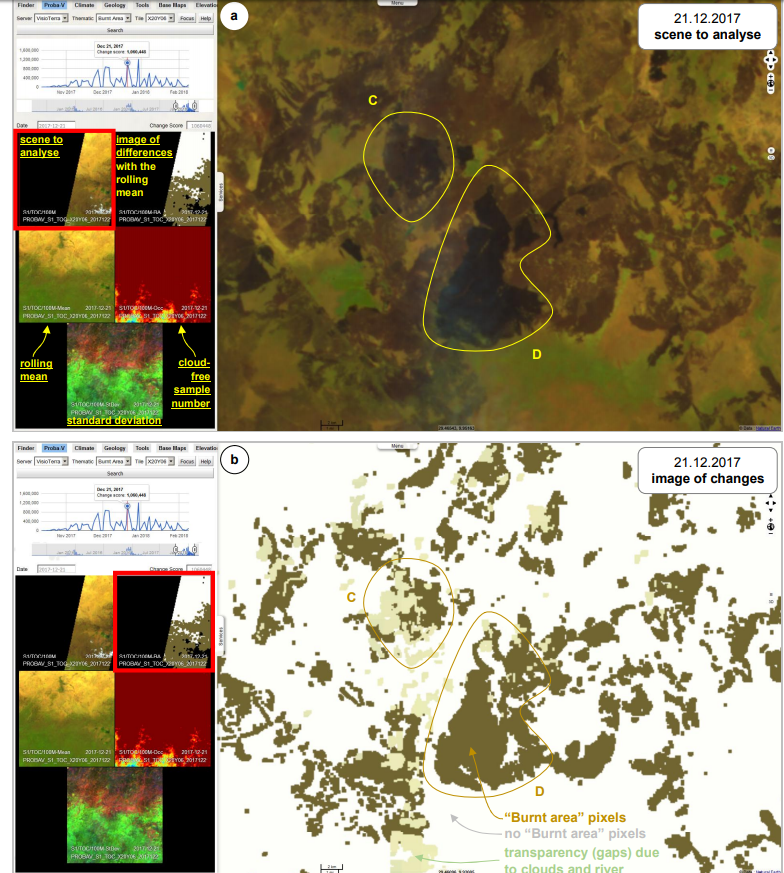VtProbaV - a Change Detection Engine
Kévin Gross – VisioTerra, France
Serge Riazanoff – VisioTerra, France
VisioTerra has developed VtProbaV, a Change Detection Engine able to automatically detect changes occurring in remote sensing data. The generic engine is declined according to different thematics. In the present project, the detection concerns the fires and burned areas detected from the 1-day synthesis of Proba-V images (S1), atmosphere-corrected (top of canopy or TOC) and at a spatial resolution of 100m, i.e. from the NADIR camera.
Whatever the thematic, the generic Change Detection Engine performs from server side routinely by a Change Detection Daemon the following actions:
- access as quickly as possible to the fresh data
- calculate the "image of difference" between the fresh data and the "rolling average"
- calculate a "change score"
- update the “rolling average” adding the fresh data.
From client side, the generic Change Detection Engine enables users to:
- select a thematic
- get the change scores over the time
- display for a given date the fresh image
- the rolling mean
- the change image
- the occurrences and standard deviation.
Running the VtProbaV application on the Proba-V MEP infrastructure at VITO enables the processing of Proba-V S1 TOC 100m products in near-real time and gives better performance.
Easy deployment of VtProbaV on a ProbaV MEP Virtual Machine
During the development phase, VtProbaV has been developed on the VtWeb infrastructure based in VisioTerra premises in Champs-sur-Marne, France. After an on-site validation, the release 1.0 of the system has been deployed on a virtual machine of the Proba-V MEP infrastructure and called VITO infrastructure in the frame of this project.
The user can select the infrastructure he/she wants to use. Both systems are running well and the Change Detection Daemons are in phase with the production of new products.
Advantage of the VITO infrastructure is the possibility to get near-real-time data each day. Drawback of the VtWeb infrastructure is to access to Proba-V S1 TOC 100m products only one (1) month after their acquisitions.
The performance of the VITO infrastructure is better with a response time of 20% to 40% greater on VITO infrastructure with regard to VtWeb infrastructure. This performance difference is due to the architecture of VtProbaV that has privileged the use of numerous I/O accesses on disks with regard to an increase of RAM or SSD disk(s).
VtProbaV prototype with high potential
The VtProbaV prototype for fire change detection and burnt area change detection shows to have high potential which could evolve to applications using data from other missions/instruments with more frequent acquisitions or more customised areas of interest.
Figure 1a shows the Proba-V scene acquired on December 12, 2017 focusing on one of the fire events located in South Sudan. Figure 1b shows in red the pixels automatically labelled as “Fire” by the service VtProbaV. Left panel shows this VtProbaV service. User can select the server (VisioTerra or VITO), thematic (“Fire” or “Burnt area”) and tile being the predefined 10°x10° tiles of the Proba-V grid for S1 products. By activating the “Search” button, a temporal chart is displayed showing the “Change score” over three years of Proba-V products processing. Users can focus on a specific time interval. By clicking on a particular point of the curve, the corresponding date is selected and five thumbnails are displayed giving the Scene to analyse, Image of differences, Rolling mean, Rolling occurrences, and Rolling standard deviation.

In fig.2, burnt area C is certainly due to the fires A and B of fig.1 while burn areas D have been produced by fires posterior to the 12 December 2017.

More information
For more information, please check:
- Newsletter published on April / May 2018
- Video showing “VtProbaV” service
- Hyperlooks document - showing some screenshots and URLs specifying the products included in a layer stack, the rendering parameters of each products for on-the-fly processing and the point of view of the scene.

